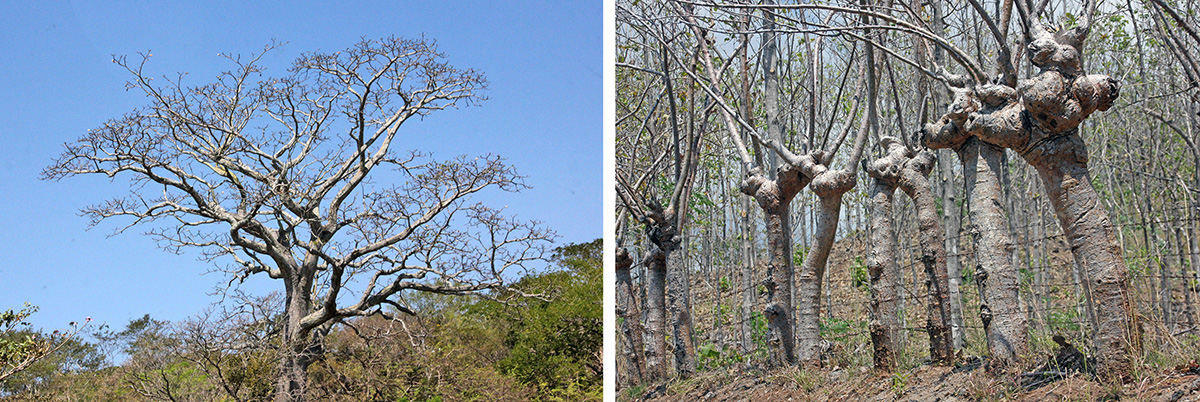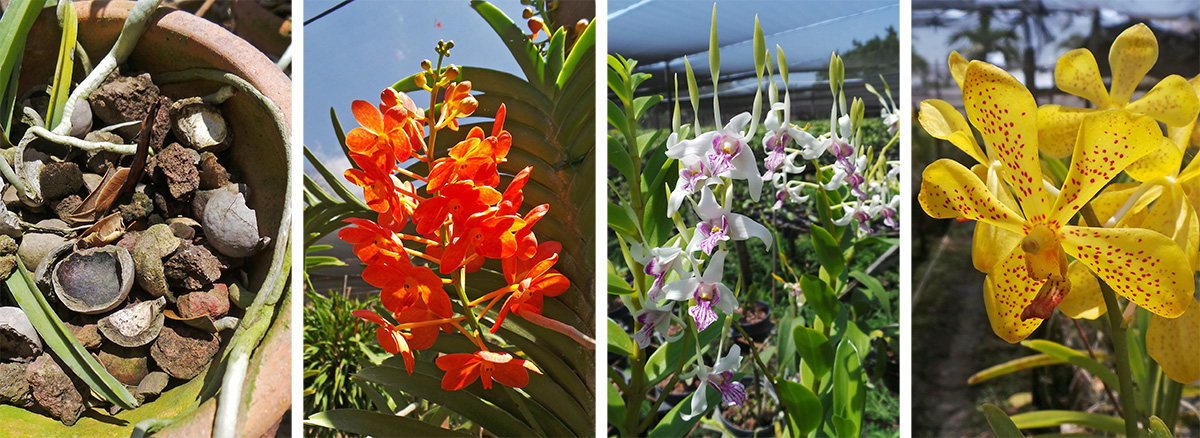Today was a long travel day, starting out with a short boat ride to the tiny airstrip in Tortuguero for an early flight back to San Jose.

On the boat to the airport (L), the colorful plane and open-air terminal at the end of the runway (C), and getting the safety briefing onboard (R).
We flew over the canals and rainforest of Tortuguero, the areas that had been cut for pasture land or housing very noticeable. Soon we were passing over mostly agricultural area, with little blocks of forest here and there. Banana plantations were large blue-green rectangles below, with a small yellow plane flying low along the rows spraying the crops in one area. Off on the left side the smoldering caldera of Volcan Turrialba soon was visible, with a small plume of smoke drifting off into the air.

Flying over the canals of Tortuguero, with Caribbean Sea in background (L), a plane spraying a banana plantation (C), and smoking Turrialba Volcano (R).
On the right side we could see the wide braided rivers meandering the Atlantic lowlands, and then soon we were going over the slopes of the Central Volcanic Range, with the deep green forested slopes of Braulio Carrillo NP. We could see the winding road we’d taken a couple days before through the National Park, then soon the area transitioned back to agriculture, then the urban area of the Central Valley. The 20-minute flight gave a great perspective on land use, and a dramatic visual demonstration of the impact of deforestation.

Braulio Carrillo National Park from the air (L), agriculture on the outskirts of the metropolitan area of San Jose (C), and blooming poró trees (Erythrina poepiggiana) amid the coffee plantations around the city (R).
We then drove out of the Central Valley to the drier, western side of the country. This is an area of dry tropical forest, with different rainfall patterns and much less rain (about 40 inches annually) than on the Atlantic side of the Continental Divide. There are almost no epiphytes here and many introduced grasses cover many of the slopes. Soon we were in the dry forest, with many flowering trees including the bright yellow buttercup (Cochlospermum spp.) and duller yellow Schizolobium parahyba trees – a favorite nesting site for scarlet macaws, especially closer to the coast – and pale pink poui (Tabebuia rosea). There were golden shower trees, Cassia fistula, with bright yellow pendant flower clusters and the related Cassia grandis with its dull rosy-pink flowers.

Blooming golden shower tree, Cassia fistula (L), pink poui, Tabebuia rosea (C), and pink shower tree, Cassia grandis (R).
Broad, spreading, mostly leafless Guanacaste trees (Enterolobium cyclocarpum) with its distinctive, ear-shaped seed pods and the similar, darker barked rain trees (Albizia saman) formed a canopy over the road in places. There were still some cecropia trees like we’d seen in the wet Atlantic areas (a different species here, though), but most of the vegetation was very different than on that rainy side of the country.

A large, leafless rain tree, Albizia saman (L) and a living fence of Bursera simaruba (R).
Everything looked dry here, with dusty open ground and many trees without leaves. The living fences here were made primarily of Bursera simaruba, with its shiny green peeling red bark inspiring common names of naked Indian or tourist tree (like a peeling sunburn).
In late morning we stopped at Café y Macadamia and Orchimex for an early lunch. Although the restaurant has a macadamia nut-themed menu, they don’t actually grow any here (that crop needs more water than would be practical to provide here; macs are grown on the Atlantic side of the mountains). We dined at the beautiful rustic tables made of highly polished local wood on the terrace behind the building, with the area under shade cloth mulched with macadamia nut shell halves and pieces. The food and beverages were beautiful and delicious.

The outdoor seating area at Café y Macadamia (L), the macadamia shell mulch (LC), Cindy showing off her fancy iced tea (RC), and Kari enjoying her lunch (R).
After eating we got to take a brief tour of the orchid operation, a large area under shade cloth filled with hybrid orchids either growing unpotted on mesh tables or in pots filled with a medium of pumice and macadamia shells, depending on the type. This is a cut flower operation, with 300 flowers harvested daily for shipment to the US, Mexico, Panama and Nicaragua.

The group touring Orchimex (L) and colorful orchid flowers (C and R).

Orchid potting medium of pumice and macadamia shells (L) and colorful orchids (LC, RC and R).
Then we were headed to head into the mountains on route 606 to Monteverde, 40 km away. The twisting, winding road took us between living fences of stout-trunked Bursera cuttings that had been topped over and over as they sprouted and grew too tall. White brahma-type cattle grazed in pastures of golden grass, and the hillsides were covered in mostly leafless trees, some blooming with flowers of white, yellow or pink. Mango trees with their lush foliage and hanging fruit stuck out amid the dry conditions. Just outside the little town of Guacimal we passed a waterfall and shortly thereafter stopped near an isolated residence for dramatic photos from the overlook of the distant dry hills.

Waterfall near the town of Guacimal (L), Cindy and Becky at the overlook (C), and dark clouds gather above the bus (R).

Panoramic view of the tropical dry forest.
Eventually we made it up to the town of Monteverde, near the private Monteverde Cloudforest Preserve that is administrated by the Tropical Science Center. Later that afternoon we went to Bajo del Tigre where we met with Willow Zuchowski, author of A Guide to Tropical Plants of Costa Rica. She gave a presentation that began by introducing us to ProNativas, a network of scientists, biologists, landscapers and gardeners in Costa Rica organized to raise awareness of the important, propagation, and use of native ornamental plants and their contribution in conservation and beauty. They have 8 gardens in the area to showcase native plants, and many partners throughout the area and in other parts of the country and receive financial support from many organizations, including the US Fish and Wildlife Service (because of the importance of Costa Rican forest to migratory birds). She also discussed the plant families with the most species in Costa Rica, mentioning some examples used locally and others we might grow at home, or as houseplants. We also had a tour of the greenhouse where they propagate native plants for their many projects, and saw a few native plants in bloom nearby.

Willow answering questions after her presentation (L), Maureen, Cindy and Becky check out the plant Willow is showing them (C), and Willow tells more about the Preserve (R).

Native chandelier vine (Mucuna sp.) in the bean family, with green, bat-pollinated flowers (L and LC) and brown seed pods (RC) hanging on long, rope-like stems. Native terrestrial orchid Epidendrum radicans (R).
